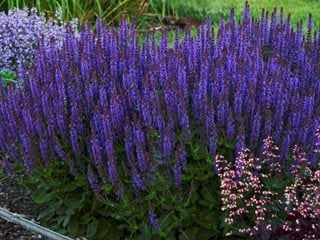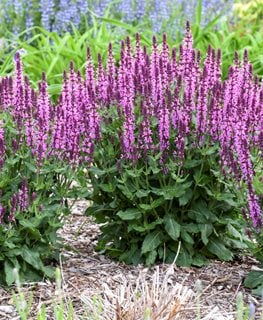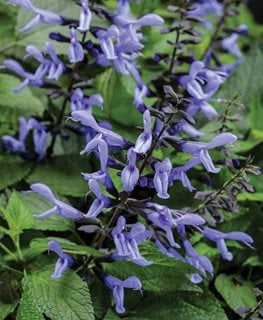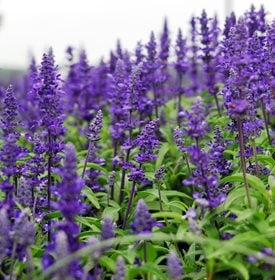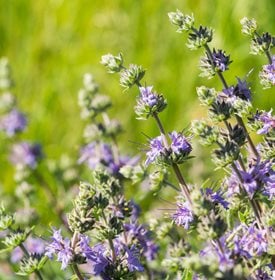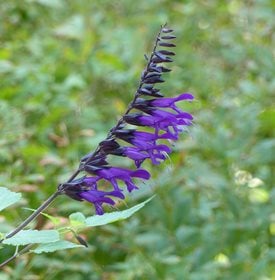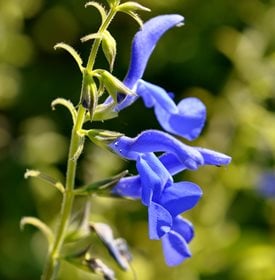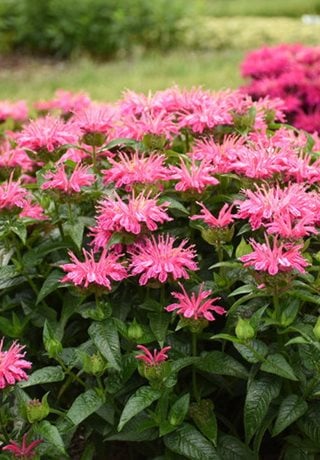Growing Salvias: How to Care for Perennial Sage Plants
Grow ornamental sages to attract hummingbirds, butterflies, and bees to your gardenWith close to 1,000 species worldwide, salvias are members of the mint family which also includes rosemary, thyme, lavender, and basil. Ornamental salvias are also a relative of common sage, the culinary herb used for cooking. Most varieties are native to hot, dry climates and can be grown as perennials.
John Whittlesey, author of The Plant Lover's Guide to Salvias, says, "Hardy perennial salvias bring strong color and form to the early summer border." Salvias are a favorite of hummingbirds, butterflies, and bees. Their drought-resistant nature and low maintenance make them a perfect choice for an easy-care garden.
On this page: Basics | Planting | Care | Design Tips | Varieties | FAQs
SALVIA BASICS
Zones:
Most varieties can be used as perennials in zones 5-9, with some varieties cold hardy to zone 4 or heat tolerant to zone 10.
Height/Spread:
Varieties 1 to 6 feet tall & wide, with most averaging 2 to 3 feet.
Exposure:
Full sun, 6 hours of sunlight a day is needed to promote flowering. There are varieties that will also tolerate partial shade. (See more full-sun perennials.)
Bloom Time:
As a rule, salvias bloom late spring to fall, with some starting a little earlier and others like S. leucantha blooming later.
Colors and characteristics:
Flower spikes bloom in shades of blue, dark purple, lavender, red, pink, white and a rare yellow. The stems are square and have narrow, velvety green leaves.
HOW TO PLANT SALVIA
When to plant:
Potted salvias can be purchased and planted in spring or fall. (Learn more about the benefits of fall planting). Seeds should be started indoors 6 to 8 weeks before last frost date, and seedlings put out after all threat of frost has passed.
Where to plant:
Picking the right spot for your salvia can make a difference in how well the plant grows and flowers. Most salvias will be happiest in a sunny spot with good drainage. Use them along your home's foundation or as part of mixed perennial borders. They can also be grown in containers. Salvias are especially nice for growing along paths because of the way they spill over and soften the edges.
Soil:
Salvia plants don't need rich soil, but they must have good drainage. If your soil is heavy, plant "proud", or slightly higher than the surrounding grade. In pots, a mixture of ordinary garden soil mixed with perlite allows water to drain rapidly. Whether in the garden or in a pot, a mulch of wood chips or small, rough-edged rock is highly recommended to not only protect the roots, but to help keep the soil temperature and moisture consistent.
Spacing:
Salvias don’t like to be crowded. When planting in groups or amongst other plants, determine the spacing based on their mature size. Space them far enough apart to ensure good air circulation.
SALVIA CARE
Water:
Most varieties of salvia are drought tolerant once established, but they'll look better with occasional water.
Pruning:
Deadheading is important to encourage repeat blooming. However, if you are looking to harvest seed, leave a few flowerheads to dry naturally on the plant. Collect the seedpods and shake out into a bag or jar.
Fertilizer:
Most salvias are light feeders and only occasionally need fertilizer. A light application of a balanced fertilizer or compost in early spring can be sufficient.
Diseases and pests:
No serious disease or pest problems affect salvia plants.
Flopping:
There are a variety of reasons salvias flop, including too much water, from rain or irrigation, not enough sun, or too much fertilizer. If your salvia plant has become leggy and flopped over you can either provide support for the plant with stakes or deadhead the flowers and let new ones grow in. Many gardeners think flopping is a sign that it is time to prune or divide their salvia. Learn more on how to divide perennials.
SALVIA VARIETIES
DESIGN TIPS

Pollinator House recipe includes Rockin'® Fuchsia salvia, Luscious® Berry Blend™ lantana, 'Pardon My Cerise' bee balm, Supertunia® Really Red, and 'Cat's Pajamas' catmint.
- The variety of flower colors, sizes, and long bloom times make salvias perfect additions to perennial borders, even when used outside their hardiness ranges as annuals.
- Salvias play well with plants having bolder foliage and larger flowers.
- Some salvias, such as S. leucantha, are late-blooming and make a glorious autumn display, extending the season of garden enjoyment.
- In containers, low-growing salvias serve as fillers or drape over the pot edge, taller types can be a centerpiece.
- Plant salvias with pleasant-scented foliage near the edge of a path or patio to enjoy the fragrance.
- Salvias are magnets for butterflies, hummingbirds and other pollinators and a perfect addition to wildlife gardens. For more, see The 24 Best Plants to Attract Hummingbirds.
OTHER USES:
- Flowers may be used as a garnish or may be added to fruit cocktails or salads.
- Leaves may be added to salads or to hot or iced teas.
- Dried leaves may be added to potpourris.
FREQUENTLY ASKED QUESTIONS
Is salvia a perennial?
Some salvias are considered annuals and others perennials. Among the perennials, there are old-world types that come from Europe and Asia, as well as American natives that come from the western half of the U.S. In addition, some salvias are classified as woody-stemmed shrubs, some are deciduous plants that die to the ground during winter, and others are evergreen.
Is salvia poisonous?
Salvia is not poisonous to dogs, cats, or horses; however, if ingested in large quantities it can cause temporary stomach upset.
Is salvia deer resistant?
Deer tend to steer clear from salvias and other sages, as they don’t like plants with a strong scent.
Will salvias grow in shade?
Most salvias prefer full sun, but there are a few types that will do well in filtered shade. Here are some options:
- Salvia verticillata ‘Purple Rain’
- Salvia romeriana ‘Hot Trumpets’
- Salvia pratensis (meadow sage)
- Salvia glutinosa (sticky sage)
- Salvia reflexa (lanceleaf sage)
Are salvias invasive?
Generally speaking, salvias do not have a reputation of being invasive. However, certain species can be a problem in specific regions. Here are ones to be aware of:
- Salvia aethiopis (Mediterranean sage) has been reported as invasive in parts of Arizona, California, Colorado, Idaho, Nevada, Oregon and Washington.
- Salvia sclarea (clary sage) and Salvia pratensis are classified as invasive in parts of Washington state.
- Salvia glutinosa and Salvia reflexa have been reported as invasive in parts of New York.
Related:
Amazing Annuals for Sun
24 Purple Flowers to Brighten Your Garden
21 Blue Flowers for Your Garden
20 Drought-Tolerant Plants for Your Garden
Pacific Northwest Plant Picks
